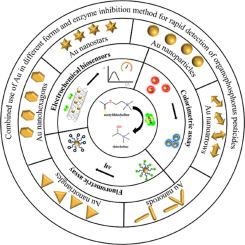Journal of Advanced Research ( IF 11.4 ) Pub Date : 2021-08-16 , DOI: 10.1016/j.jare.2021.08.008 Rongqi Zhai 1 , Ge Chen 1 , Guangyang Liu 1 , Xiaodong Huang 1 , XiaoMin Xu 1 , Lingyun Li 1 , Yanguo Zhang 1 , Jing Wang 2 , Maojun Jin 2 , Donghui Xu 1 , A M Abd El-Aty 3, 4, 5

|
Background
Organophosphorus pesticides (OPs), as insecticides or acaricides, are widely used in agricultural products to ensure agricultural production. However, widespread use of OPs leads to environmental contamination and significant negative consequences on biodiversity, food security, and water resources. Therefore, developing a sensitive and rapid method to determine OPs residues in different matrices is necessary. Originally, the enzyme inhibition methods are often used as preliminary screens of OPs in crops. Many studies on the characteristic of Au nanomaterials have constantly been emerging in the past decade. Combined with anisotropic Au nanomaterials, enzyme inhibition methods have the advantages of high sensitivity, durability, and high stability.
Aim of Review
This review aims to summarize the principles and strategies of gold (Au) nanomaterials in enzyme inhibition methods, including colorimetric (dispersion, particle size of Au nanomaterials) and fluorometric (fluorescence energy transfer, internal filtration effect) detection, and electrochemical sensing system (shape of Au nanomaterials, Au nanomaterials combined with other nanomaterials). The application of enzyme inhibition in agricultural products and research progress was also outlined. Next, this review illustrates the advantages of Au nanomaterial-based enzyme inhibition methods compared with conventional enzyme inhibition methods. The detection limits and linear range of colorimetric and fluorometric detection and electrochemical biosensors have also been provided. At last, key perspectives, trends, gaps, and future research directions are proposed.
Key Scientific Concepts of Review
Herein, we introduced the technology of enzyme inhibition method based on Au nanomaterials for onsite and infield rapid detection of organophosphorus pesticide.
中文翻译:

基于金纳米材料的酶抑制方法快速检测农业和环境样品中的有机磷农药:综述
背景
有机磷农药(OPs)作为杀虫剂或杀螨剂被广泛应用于农产品中,以保障农业生产。然而,有机磷农药的广泛使用会导致环境污染,并对生物多样性、粮食安全和水资源产生重大负面影响。因此,有必要开发一种灵敏、快速的方法来测定不同基质中 OPs 的残留量。最初,酶抑制方法通常用作作物中 OPs 的初步筛选。近十年来,许多关于金纳米材料特性的研究不断涌现。结合各向异性的Au纳米材料,酶抑制方法具有灵敏度高、耐久性强、稳定性高等优点。
审查目的
本综述旨在总结金(Au)纳米材料在酶抑制方法中的原理和策略,包括比色法(Au纳米材料的分散、粒径)和荧光法(荧光能量转移、内滤效应)检测,以及电化学传感系统(形状金纳米材料,金纳米材料与其他纳米材料结合)。并概述了酶抑制在农产品中的应用及研究进展。接下来,本综述说明了基于金纳米材料的酶抑制方法与传统酶抑制方法相比的优势。还提供了比色和荧光检测以及电化学生物传感器的检测限和线性范围。最后,主要观点、趋势、差距、
审查的关键科学概念
本文介绍了基于Au纳米材料的酶抑制法现场和现场快速检测有机磷农药的技术。










































 京公网安备 11010802027423号
京公网安备 11010802027423号